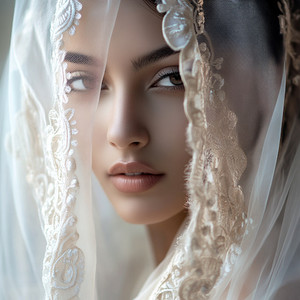Veil or No Veil? The Tradition, Trends, and Why It Still Matters Today
- Anjelina S
- Oct 9, 2024
- 3 min read
To veil or not to veil? 💍 It's one of the most iconic bridal choices you'll make! Whether you're dreaming of timeless tradition or modern elegance, the history of the wedding veil has evolved just like wedding trends. In today’s blog, we’re diving into the rich history behind veils, the latest bridal fashion trends, and some personal opinions to help you decide if this classic accessory is the right fit for your big day. Let’s explore whether the veil should be part of your 'I Do' look!

Around the World, Veil or No Veil
The practice of wearing a veil carries deep cultural and religious significance across various societies. In Islamic cultures, the veil, or hijab, symbolizes modesty and devotion to faith. It is viewed as a form of spiritual humility, where women choose to cover their hair and bodies to honor religious teachings. In Hindu traditions, wearing a veil, or ghoonghat, is often tied to modesty and respect, especially in more conservative areas of India, symbolizing a woman's purity and reverence. However, many Hindu women no longer wear veils, signifying evolving gender norms. Across cultures, the veil can be a symbol of identity, spirituality, or social standing, with different perspectives ranging from a display of modesty to a personal choice, reflecting changing attitudes on traditions.
"Whether you wear a veil or not, your beauty is what takes their breath away. 💫👰 #VeilOrNoVeil #UnveilYourself"
Angelina Stanley
For centuries, the wedding veil has been a staple of bridal fashion. But what does it really symbolize? And in today’s modern weddings, is it still necessary?
Historically, the veil represented purity and modesty, rooted in ancient Roman traditions where it was believed to ward off evil spirits. In the Victorian era, the length and material of a veil symbolized social status, making it a luxurious accessory for the wealthy.
Across different cultures, the veil has also carried religious connotations—used in Jewish, Christian, and Islamic ceremonies to signify modesty and sacredness .Today, the veil has evolved into more of a personal style statement. While some brides continue to embrace the veil for tradition, others ditch it in favor of modern, minimalist looks. Current trends see brides opting for shorter veils or even colored ones to match their unique wedding aesthetics .
To veil or not to veil? It’s a deeply personal choice, and I wholeheartedly respect and appreciate the rich traditions behind both decisions. Throughout my journey as a wedding planner, I've had the honor of organizing celebrations for couples from diverse cultures and religions across the globe, each with their own beautiful customs. Whether a veil is part of your ceremony or not, what truly matters is the love and commitment shared on your special day.
At the core of every union is something timeless and universal. From the dawn of humanity, the tradition of a ceremonial union has transcended culture, religion, and gender. It is an essential part of the human experience—a testament to our need for connection, love, and unity. After all, it is through joining together that we, as humans, thrive and survive. 💍
Planning a wedding in breathtaking Tuscany or know someone who is? I'd love to hear all about it! Share your thoughts in the comments, or drop me a message at angelina@posheventvenues.com—Where forever Begins! 💍✨





Comments